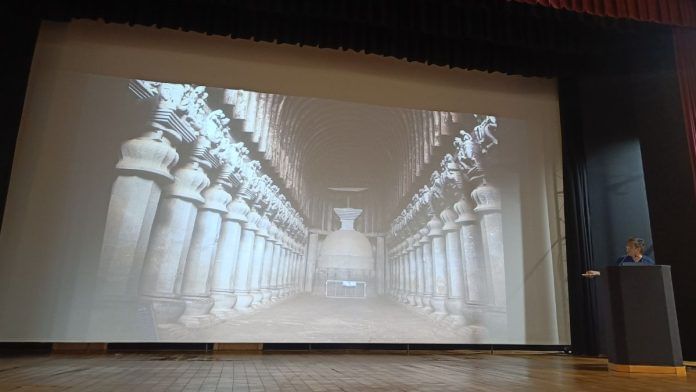New Delhi: At a recent lecture at the National Museum, a scholar shed light on an unexplored aspect of Buddhist nuns — their role as donors in ancient India, who helped build the largest rock-cut cave complex in Maharashtra in the 2nd century BCE, centuries before the famous Ellora caves came into existence.
In a hall full of history enthusiasts, professor Abhijit Dandekar, from the Department of Ancient Indian History, Culture, and Archaeology at the Deccan College Postgraduate and Research Institute in Pune, pointed to a wall of the Karle complex showing elephants carved from donations.
“The inscription suggests that a Buddhist monk gave donations for this carving,” he said.
The inscription intrigued Dandekar, as Buddhism prohibits monks and nuns from holding money.
“Instead, we see that the monks and nuns have given a donation,” he said.
Karle cave complex: Ancient Buddhist crowdfunding
The Karle cave complex was the largest and most significant of its time in the Indian subcontinent.
Ruling families such as the Satavahanas, Maharathis and Mahabhojas funded the making of caves, said Dandekar. His 50-minute lecture, titled Ancient Crowdfunding: Society and Patronage at the Karle Cave Complex, was part of the museum’s monthly public lecture series attended by art scholars, archaeologists, and history students.
The Karle Cave Complex in Pune features the subcontinent’s largest chaitya (prayer hall) for worship and meditation, with a stupa at the foothills of the Sahyadri mountains, also known as Western Ghats. Inscriptions reveal how royal patronage and individual donors sustained Buddhism in early Maharashtra, making Karle a cultural hub for centuries.
“These cave complexes emerged around the 2nd century BCE and continued until the 10th-11th centuries CE,” said Dandekar.
Buddhist monastic architecture in Maharashtra
Maharashtra had Chalcolithic and Megalithic cultures before Buddhism spread around the 3rd century BCE. By the 2nd century BCE, Buddhist monasteries began to appear.
“The evidence of Buddhism and Buddhist monastic order is in the form of rock-cut caves,” said Dandekar, adding that the earliest written records are Ashokan edicts found in Nalasopara, Maharashtra.
In Buddhist monastic architecture, two types of caves are common — chaityas (prayer halls) and viharas (residential quarters).
Dandekar recounted the story of Punda, a businessman from Aparanta, the ancient west coast, who invited Buddha to visit the region despite believing that it was full of dacoits and robbers.
“This region was known to people in North India around the 5th-6th century BCE,” said Dandekar.
The western region of Maharashtra houses many rock-cut cave complexes such as Bhaja, Bedse and Karle. But inscriptions about financial patronage survive only at Karle.
For instance, the Bhaja caves, a group of 22 rock-cut caves near Pune dating to the 2nd century BCE, have sparse inscriptions. “In the Bhaja group of caves, a very nondescript kind of inscription is there,” said Dandekar.
Similarly, the Bedse caves, 9 km away and traced back to the Satavahana period, have faint inscriptions. “Some inscriptions at Bedse talk about a stupa built in memory of a monk who was an Aranyavasin (forest-dweller monk),” he added.
At Karle cave complex, however, the story of patronage and financial support is much richer and more complex.
Royal patronage and tax-free villages
There are examples of royal donations. The Maharathi family donated the village Velurakha (later known as Karle) to the Buddhist Sangha.
Over time, the caves saw changes and even vandalism. In one case, a Buddha figure was carved over the inscriptions, Dandekar said.
One inscription mentions Ushavadatta, a viceroy and son-in-law of western Kshatrapa ruler Nahapana.
“This is the ancient son-in-law who has written on behalf of his father-in-law, who was quite active in politics like many sons-in-law in modern time,” said Dandekar, adding that the inscription talks about the donation of a village name Karajika.
Dandekar said the inscriptions also note that the government had no role in maintaining the monastery and that the army was barred from entering the area. “So this was a free village, free of all taxes,” he said.
Inscriptions reveal women donors at Karle caves
Most inscriptions at Karle are in Prakrit, carved in bold letters. “This is a very interesting way of writing,” observed Dandekar.
Faint inscriptions — all attributed to women donors — are written in shallow characters, often in the darker interiors of the cave.
When someone in the audience asked why it was so, Dandekar gave possible reasons. “It could be that women paid less money or those in charge of the project would have the liberty or the discretionary powers to decide. There is only scope to think that way. There is no evidence.”
Many scholars, from James Burgess, B Indraji, E Senart, MS Vats, K Gopalachari to GS Ghai, have studied the 36 inscriptions, with Burgess’s decipherments of 22 inscriptions published in ASI’s Annual Reports of Western India.
Most inscriptions record donations for the upkeep of the monastery or for architectural features such as lion pillars, doorways, railings, images of elephants and couples. A majority mention donations for individual pillars.
“This was a kind of crowdfunding, where Kings, merchants and individuals gave donations and together established this beautiful monastery. It was a work of coming together,” said Dandekar.
(Edited by Prashant)






